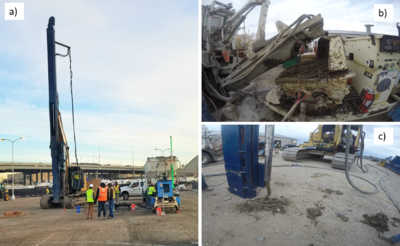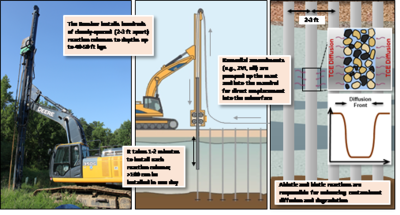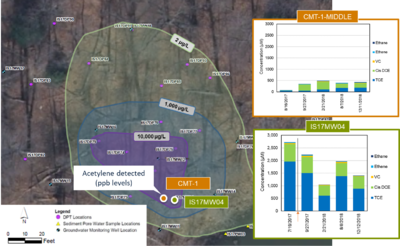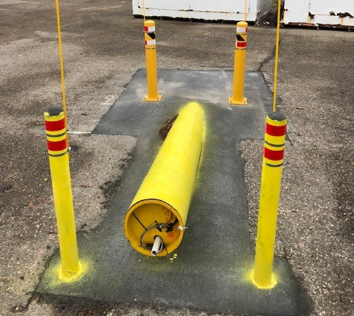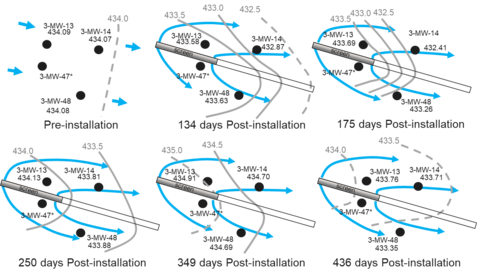Amendment Distribution in Low Conductivity Materials
The persistent release of residual contaminants from low hydraulic conductivity (low k) zones prevents many chlorinated solvent sites from reaching groundwater cleanup goals. Low k aquifer settings limit the effectiveness of many conventional remediation technologies that rely on extraction, recirculation, or amendment delivery and distribution to achieve contact between the residual contaminants and the reagents, contact which is necessary for subsequent contaminant transformation or destruction. Alternative methods are needed to effectively distribute remedial amendments, to control contaminants leaving low k source zones, and to enhance natural attenuation processes. Two innovative remediation technologies for the treatment of chlorinated solvents and other contaminants in low k media are introduced, along with operational and performance results from recent field demonstrations.
Related Article(s):
CONTRIBUTOR(S):
Key Resource(s):
- The Horizontal Reactive Media Treatment Well (HRX Well®) for Passive In-Situ Remediation[1]
- The Horizontal Reactive Media Treatment Well (HRX Well®) for Passive In Situ Remediation: Design, Implementation, and Sustainability Considerations[2]
- New Application of A Geotechnical Technology to Remediate Low-Permeability Contaminated Media – Final Technical Report[3]
Introduction
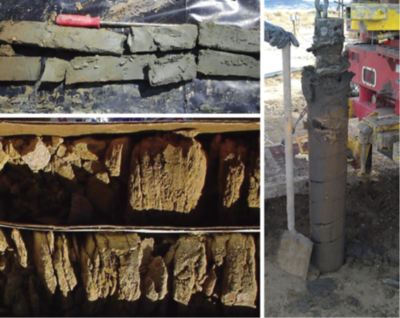
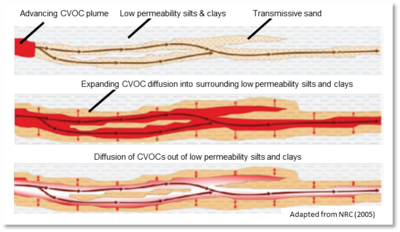
A critical challenge preventing many chlorinated solvent sites from achieving groundwater cleanup goals is the long term release of residual contaminants from low hydraulic conductivity (low k) zones such as silts, clays, glacial till, over-bank deposits, marine deposits, tailings “slimes”, saprolite and bedrock (see Figure 1)[4][6]. Such sites may be dominated by matrix diffusion processes (see Figure 2) which can significantly prolong restoration and site management timeframes. Residual contaminants residing in low permeability zones slowly diffuse from the low k matrix back into higher permeability zones, becoming a persistent source that is very difficult to remediate. One of the side effects of matrix diffusion is concentration rebound after an in situ treatment is applied. This is commonly observed at sites treated with chemical oxidation[7][8] and has the potential to occur at in situ bioremediation sites after the depletion of electron donors[9].
Currently, there are limited remediation options available to treat residual contamination trapped in low k zones. Low k settings limit the applicability and effectiveness of conventional remediation technologies due to the constraint on fluid introduction and recovery. As such, methods relying on extraction, recirculation, or reagent delivery and distribution are often limited in their effectiveness. For the long lived, difficult to treat sites, innovative technologies are needed that will reliably address mass flux limitations of contaminants leaving low k source zones, and also increase the actual treatment of the contaminants leaving these low k zones by enhancing natural attenuation processes. Two innovative technologies investigated by ESTCP are summarized below.
“Grout Bomber”
Technology Description
The geotechnical industry offers a variety of well-established techniques for quickly and efficiently accessing the subsurface for the purposes of ground stabilization, foundation rehabilitation, porewater drainage, and structural support. The speed and efficiency of these techniques can also be a major advantage for emplacement of remedial amendments into the subsurface. One promising approach is the Grout Bomber, a larger adaptation of conventional cement or compaction grouting techniques for subsurface stabilization. The technology uses an excavator equipped with specialized equipment (a “stitcher”) to quickly push a mandrel (3.5 in. diameter hollow cylindrical rod) into the subsurface and subsequently fill the hole and subsurface voids with cement grout (from bottom to top) using an in-line grout delivery system. The typical arrangement of the Grout Bomber technology includes the installation rig (excavator with the “stitcher” mast; see Figure 3a) and an on-site grout mixing and delivery unit consisting of mixing hopper, pumps, hosing, and power supply. Raw materials are loaded into the mixing hopper (see Figure 3b) where it is mixed to the appropriate consistency, then pumped to the Bomber rig at a rate of approximately 0.25 cubic feet per pump stroke. At the exit end of the Bomber mandrel (see Figure 3c), the grout flows in a continuous and uniform manner, allowing the columns to be emplaced with grout while the mandrel (which was pushed into the subsurface) is lifted to the surface. Hundreds of closely spaced vertical grout columns can be installed per day using this technology.
For environmental applications, the Grout Bomber approach can be “repurposed” as a means to improve delivery of remediation amendments into contaminated treatment zones in low k materials. The remedial amendment (e.g., mixture of zero-valent iron (ZVI), sand, neat oil) can replace the grout and be directly placed into the subsurface from bottom to top (not injected into the surrounding formation), creating hundreds of reaction columns. The Bomber technology offers the following benefits:
- Reduces uncertainty:
The Bomber technology circumvents the “delivery problem” associated with conventional injection-based remediation approaches, particularly in low k zones. The closely spaced nature of the reaction columns (2-3 ft spacing) reduces the diffusion lengths out of low k zones and also the uncertainty associated with amendment delivery because contaminants are always < 1 - 1.5 ft from an active treatment zone (see Figure 4).
- Rapid installation of reaction columns:
The Grout Bomber can install 100+ reaction columns per day to depths of 40-50 ft below ground surface (bgs) to encourage contaminant degradation in source zones. Since the Grout Bomber is a direct push technique, it is better suited to silts and clays with blow counts < 35. Consolidated materials with higher blow counts will require additional equipment to pre-drill the columns prior to amendment emplacement. In general, this technology represents a much simpler, less intensive, and easier to install version of complete soil mixing.
- Accommodates various amendment types:
In one example[3], vertical reaction columns containing a mixture of ZVI, vegetable oil, sand and minor amounts of water were installed to a depth of 30 ft bgs in a low k treatment area consisting primarily of silts, sandy clays, and lean clays[2]. The ZVI-sand-oil mixture was designed to have a similar consistency (or viscosity) to cement grout, thus requiring no major alterations to the existing Bomber equipment for the project. Recommended practices to ensure uninterrupted flow of amendments to the Bomber mandrel include:
- Conduct simple pumping pilot studies with amendments of varying consistencies,
- Consult with a well trained pump operator, and
- Minimize the length of hosing between mixing hopper pump and Bomber mandrel.
- Cost effective source zone treatment:
Estimated treatment costs associated with emplacement of amendments with the Grout Bomber are ~$35 per cubic yard of source zone treated (including contractor labor, equipment, and materials). This is generally less than the reported unit cost for in situ biodegradation ($20-$80/yd3) and significantly less than chemical oxidation ($125/yd3) and thermal remediation (median $200/yd3)[10].
Operational Approach & Results
A field demonstration was conducted at Site 17, Naval Support Facility Indian Head, Maryland. The treatment area consists primarily of silts, sandy clays, and lean clays with TCE concentrations in soil and groundwater of up to 250 mg/kg and 400 mg/L, respectively. Eight hundred reaction columns (consisting of ZVI/sand or oil/sand), were installed 2-3 ft apart, to a depth of 30 ft bgs at the site. Approximately 100 reaction columns were installed per day, with the most productive day totaling 180 columns. During operation, installation time for each reaction column was on the order of 1-2 minutes. Overall, 77,000 lbs of ZVI and 650 gallons of vegetable oil were emplaced within the source area of ~5,000 ft2.
Performance Results
Ongoing post installation monitoring of treatment area groundwater has found moderate reductions in TCE in site monitoring wells and that key degradation products that serve as indicators for both abiotic and biotic mechanisms (i.e., acetylene, ethene/ethane) are present. Samples from Continuous Multilevel Tubing (CMT) wells installed within reaction columns (anulus filled with ZVI amendment) have demonstrated 1-3 orders of magnitude reductions in TCE relative to the surrounding formation water (see Figure 5). These results provide evidence that the reaction columns are creating steep concentration gradients that could drive contaminants out of low permeability zones. Further, gaseous products (e.g., propane, propene, i-butane, n-butane, n-pentane, n-hexane) were detected in the unsaturated zone of several reaction columns further supporting abiotic TCE degradation. Results of this full scale project were very promising and, although several operational improvements were identified (e.g., improved pumpability of ZVI/sand mixture; minor equipment modifications; improved site prep practices), the Bomber technology has the potential to be an important remediation alternative for hard-to-treat chlorinated source zones, particularly ones with large, persistent matrix diffusion sources over large areas.
Horizontal Reactive Treatment Well (HRX Well®)
| Reactive Media | Potential Target Groundwater Contaminants |
|---|---|
| Zero valent iron (ZVI) Bimetallics (e.g., ZVI + Pd, Pt, or Ni) |
Chlorinated solvents (CVOCs), nitrate, perchlorate, energetics, chromium, arsenic |
| Granulated activated carbon (GAC) Organosilicates |
CVOCs, Poly- and Perfluoroalkyl substances (PFASs), hydrocarbons, halomethanes |
| Sustained Release Oxidants | CVOCs, 1,4-dioxane, hydrocarbons, polyaromatic hydrocarbons (PAHs), phenolic compounds |
| Biodegradable particulate organic carbon (e.g., mulch) |
CVOCs, nitrate, perchlorate, energetics |
| Ion exchange resins | PFAS, brines |
| Phosphates (e.g., apatite) | Lead, uranium, other metals and radionuclides |
| Limestone, lime, magnesium oxide | Low pH, acid rock drainage |
| Barium sulfate (barite) | Radium |
| Iron sulfide | Chromium, high pH |
| Zeolites | Ammonium, radionuclides, PFAS |
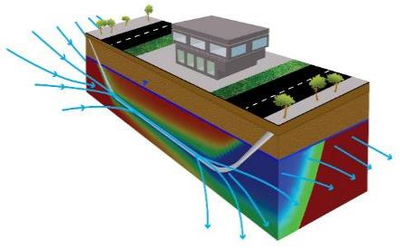
The Horizontal Reactive Media Treatment Well (HRX Well®)[11][1][2] is a new passive flux-control technology that utilizes large diameter horizontal wells filled with solid phase reactive media to treat contaminated groundwater in situ. The HRX Well is installed parallel to the direction of groundwater flow and the design leverages natural “flow focusing” behavior induced by the engineered contrast in hydraulic conductivity between the reactive media and the ambient aquifer hydraulic conductivity to passively capture and treat proportionally large volumes of groundwater within the well. Treated groundwater then exits the horizontal well along its down-gradient sections (Figure 6). The HRX Well can quickly reduce contaminant mass flux and control migration, however it will not directly treat source mass or contamination located in low permeability zones. It requires a limited above-ground footprint (Figure 7) and can be installed under buildings or other surface infrastructure. In involves no active groundwater management or above ground treatment systems, and minimal ongoing maintenance (except for periodic media replacement as the media becomes exhausted). As shown in Table 1, many different types of solid reactive media are already available; therefore, this concept could be used to address a wide range of contaminants. Note that it is anticipated that solid phase media would be used in most applications, however, other media types or treatment processes could conceivably be employed. It is expected that reactive media use would be more efficient, and its eventual replacement would be simpler and less costly for an HRX Well than for a conventional Permeable Reactive Barrier (PRB).
For relatively thin aquifers, the vertically averaged capture and treatment zone width (wave) for an individual well can be estimated through a simple manipulation of Darcy’s Law[1]:
Equation 1. wave = (KHRX π rHRX2 iHRX) ⁄ (KA bA iA) Where: KHRX is the hydraulic conductivity of the treatment media, rHRX is the radius of the HRX Well, iHRX is the hydraulic gradient along the HRX Well, KA is the average hydraulic conductivity of the aquifer, bA is the targeted aquifer zone thickness, and iA is the ambient aquifer hydraulic gradient.
In all cases, iHRX < iA, but for short wells, iHRX << iA, and wave is small. However, for long wells (several hundred feet or more), the difference between the hydraulic gradients diminishes. When used as a screening calculation, iHRX and iA can be assumed to be approximately equal in many cases. By inspection of Equation 1, it is clear that wave increases as the permeability contrast between the aquifer and reactive media increases, and therefore this approach may be practical and cost effective for many moderate and lower permeability sites. If necessary, multiple HRX Wells can be installed side by side to achieve target treatment widths.
The HRX Well concept has been evaluated with numerical models and physical sand tank experiments[1][2], and the first field scale installation of this technology was completed in August 2018 at Vandenberg Air Force Base (VAFB) in Central California. This purpose of the HRX Well is to control trichloroethene (TCE) flux in a thin (7 to 12 ft) low permeability aquifer (average hydraulic conductivity is approximately 0.1 to 0.5 ft/day) impacted at concentrations up to about 30 to 50 milligrams per liter (mg/L). The HRX Well consists of 85 ft of inlet screen and 70 ft of outlet screen separated by 165 ft of casing, with removeable treatment media cartridges (35 percent ZVI by weight, media hydraulic conductivity is approximately 100 ft/d) installed in 70 ft of the cased section. Hydraulic performance data (as shown in Figure 8) and treatment effectiveness data (Figure 9) indicate the following:
- The capture and treatment zone for this single HRX Well exceeded 50 ft, consistent with estimates predicted by Equation 1.
- TCE concentrations were reduced by more than 99.99% based on concentrations at the HRX Well outlet.
- Initial treatment response was observed in nearby monitoring wells generally within 150 days after HRX Well installation, which is consistent with the design model.
- 436 days after HRX Well installation, the TCE concentration in treatment wells was reduced by an average of 63%.
For this site, the HRX Well concept compared favorably in terms of sustainability, relative to pump and treat (P&T) and conventional trench based PRB approaches. The system operates passively in situ, therefore, the recurring and cumulative energy requirements, carbon footprint, life cycle water consumption, recurring material use, and waste generation are low, and are primarily associated with replacement of treatment media. For the VAFB site, ZVI is contained in removable cartridges that are anticipated to require replacement every five to 10 years. However, media replacement frequency is site specific and a function of contaminant loading and treatment media volume and characteristics. Lifecycle cost estimates for full-scale 30-yr systems also compared favorably: $2.5M to $3.1M for a three well HRX Well system, $3.8M to $4.7M for a P&T system, and $3.6M to $4.5M for a PRB design.
References
- ^ 1.0 1.1 1.2 1.3 1.4 Divine, C. E., Roth, T, Crimi, M., DiMarco, A.C., Spurlin, M., Gillow, J., and Leone, G., 2018. The Horizontal Reactive Media Treatment Well (HRX Well®) for Passive In-Situ Remediation. Groundwater Monitoring & Remediation, 38(1), pp. 56–65. DOI: 10.1111/gwmr.12252
- ^ 2.0 2.1 2.2 2.3 Divine, C.E., Wright, J., Wang, J., McDonough, J., Kladias, M., Crimi, M., Nzeribe, B.N., Devlin, J.F., Lubrecht, M., Ombalski, D., Hodge, B., Voscott, H., and Gerber, K., 2018. The Horizontal Reactive Media Treatment Well (HRX Well®) for Passive In Situ Remediation: Design, Implementation, and Sustainability Considerations. Remediation, 28(4), pp. 5-16. DOI: 10.1002/rem.21571 Also available from: ResearchGate
- ^ 3.0 3.1 Richardson, S.D., Hart, D.M., Long, J.A., and Newell, C.J., 2020. New Application of A Geotechnical Technology to Remediate Low-Permeability Contaminated Media – Final Technical Report. ER-201627, Environmental Security Technology Certification Program (ESTCP). Project Overview
- ^ 4.0 4.1 Horst, J., Divine, C., Schnobrich, M., Oesterreich, R., and Munholland, J., 2019. Groundwater Remediation in Low-Permeability Settings: The Evolving Spectrum of Proven and Potential. Groundwater Monitoring & Remediation, 39(1), pp. 11-19. DOI: 10.1111/gwmr.12316
- ^ National Research Council, 2005. Contaminants in the Subsurface: Source Zone Assessment and Remediation. National Academies Press, Washington, DC, pp. 372. DOI: 10.17226/11146 Book.pdf
- ^ Sale, T., C. Newell, H. Stroo, R. Hinchee, and Johnson, P., 2008. Frequently Asked Questions Regarding Management of Chlorinated Solvents in Soils and Groundwater. Environmental Security Technology Certification Program (ESTCP) Project ER-0530, 38 pp. Report.pdf Project overview
- ^ McGuire, T.M., McDade, J.M., and Newell, C.J., 2006. Performance of DNAPL Source Depletion Technologies at 59 Chlorinated Solvent-Impacted Sites. Groundwater Monitoring & Remediation. Volume 26, Issue 1, pp. 73-84. DOI: 10.1111/j.1745-6592.2006.00054.x Free download.pdf
- ^ Krembs, F., Siegrist, R., Crimi, M., Furrer, R., and Petri, B., 2010. ISCO for Groundwater Remediation: Analysis of Field Applications and Performance. Groundwater Monitoring & Remediation, 30(4), pp. 42-53. DOI: 10.1111/j.1745-6592.2010.01312.x
- ^ Adamson, D., McGuire, T., Newell, C., and Stroo, H., 2011. Sustained Treatment: Implications for Treatment Timescales Associated with Source-Depletion Technologies. Remediation, 21(2), pp. 27-50. DOI: 10.1002/rem.20280
- ^ McDade, J.M., T.M. McGuire, and Newell, C.J., 2005. Analysis of DNAPL Source Depletion Costs at 36 Field Sites, Remediation, 15(2), pp. 9-18. DOI: 10.1002/rem.20039
- ^ Divine, C.E., Leone, G., Gillow, J, Roth, T., Brenton, H., and Spurlin, M., 2013. Horizontal In-well Treatment System and Source Area Bypass System and Method for Groundwater Remediation. U.S. Patent US8596351 B2. U.S. Patents and Trademarks Office, Alexandria, VA. Patent.pdf
